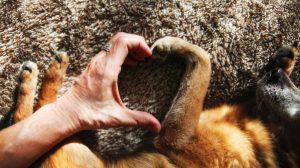You can teach them commands and other desired behaviors more quickly if you understand how dogs learn. The four-legged friend perceives certain information via its sensory organs, processes it in the brain, and stores it in the memory, where it can then retrieve it. The following tips will tell you what this means for you and dog training.

The learning behavior of dogs can be divided into obligatory and optional learning. What he needs to survive is part of compulsory learning. Anything beyond that, such as human commands, tricks, and dog sports, falls within optional education. However, both follow the same learning processes; both associative learning behavior and learning through observation and imitation play a role.
Associative learning behavior in dogs
Associative learning behavior is based on the principle of cause and effect or stimulus and reaction. Your dog associates a specific stimulus within half a second with a corresponding response. If he experiences that the same inspiration always follows the same answer, he saves this as a rule and remembers it. If he wants to achieve this effect in the future, he knows that he must first take care of the cause.
For example, You want to teach your dog the “sit” command. In the beginning, you keep saying “sit” until your four-legged friend actually sits down and rewards this immediately with a treat. If you repeat this often enough, your smart guy will understand that when he sits down on the command “sit,” he gets something nice in return. In the beginning, you will need lots of treats to motivate him, but gradually your dog will memorize the essential information – that it is pleasant to listen to your command.
The use of positive and negative reinforcement in dog training is helpful to consolidate associative learning behavior, i.e., to get dogs to internalize a specific cause-effect rule and recall it automatically. The animal receives a reward in the former, and something pleasant is added. In the latter, something unpleasant is fixed. In addition, there is the (controversial, since working with aversive training methods) positive punishment. The dog gets to feel an undesirable effect of unwanted behavior. Negative punishment interrupts something pleasant.
For example, if your four-legged friend pulls on the leash while walking, the negative punishment is that you stop. When he relaxes, move on and use negative reinforcement. He learns that the nice walk is interrupted when he pulls on the leash and continues when he stops. Positive punishment, in this case, would be a tug on the leash; positive reinforcement would be praise, a pet, or a treat when the dog relaxes.
Social learning behavior through observation and imitation
However, the dog’s learning behavior does not only work by collecting its own experiences and the resulting associations. Observation followed by imitation is also an important learning technique. The social learning behavior of dogs among each other is mainly based on observation and models; the little puppies learn everything necessary about dog communication and dog behavior from the older pack members and their parents. This includes dangers and information about potential enemies, food sources, and other resources.
The young animals observe in the experienced dogs that a corresponding effect follows a particular behavior. If they want to achieve this effect, they try out the observed behavior themselves – and the learning process is already in full swing. Over time, those willing to learn understand that it is worthwhile for them to pay attention to their peers’ behavior and imitate it if necessary. You can take advantage of this for dog training by showing your four-legged friend that it pays off for him to observe you and, if necessary, to imitate your behavior or establish a corresponding behavior on command.








